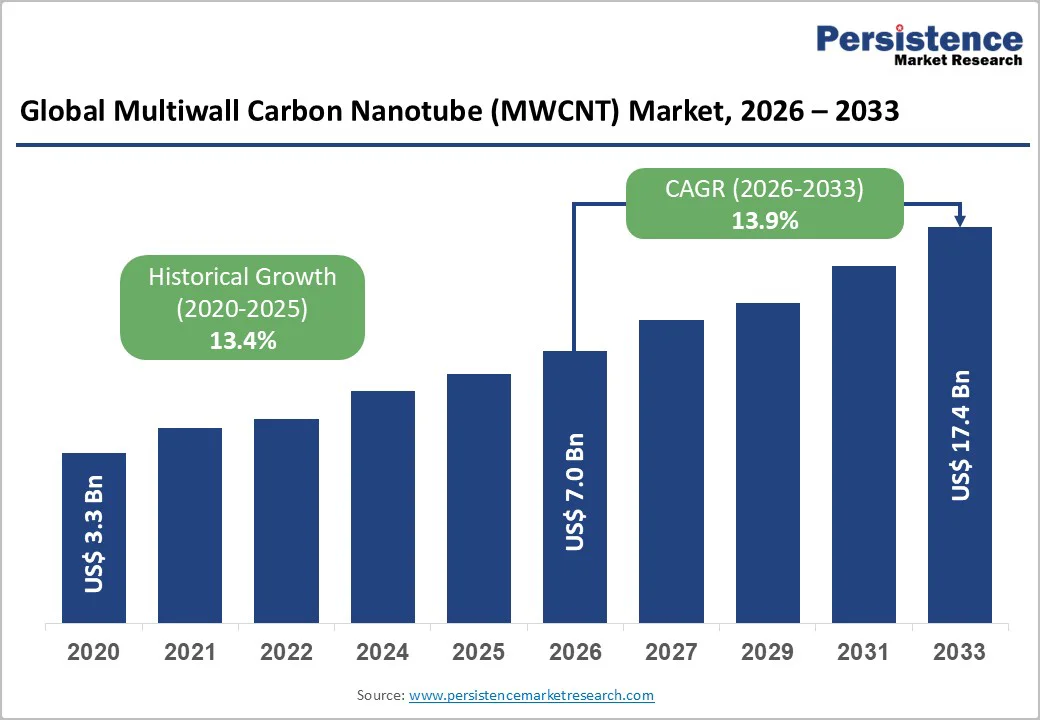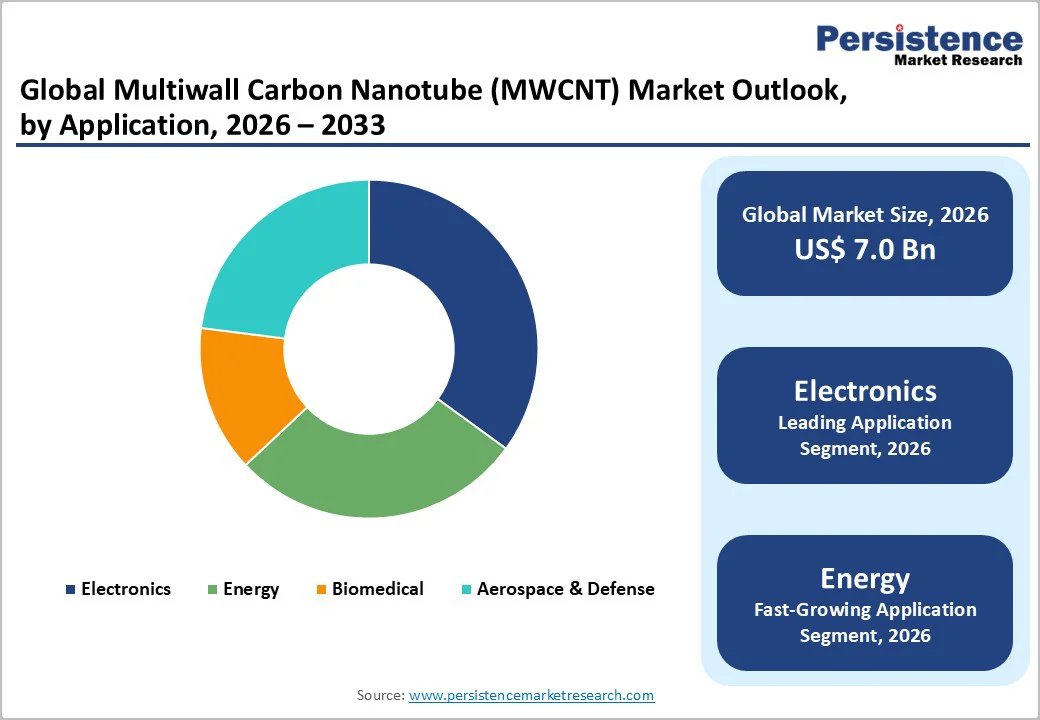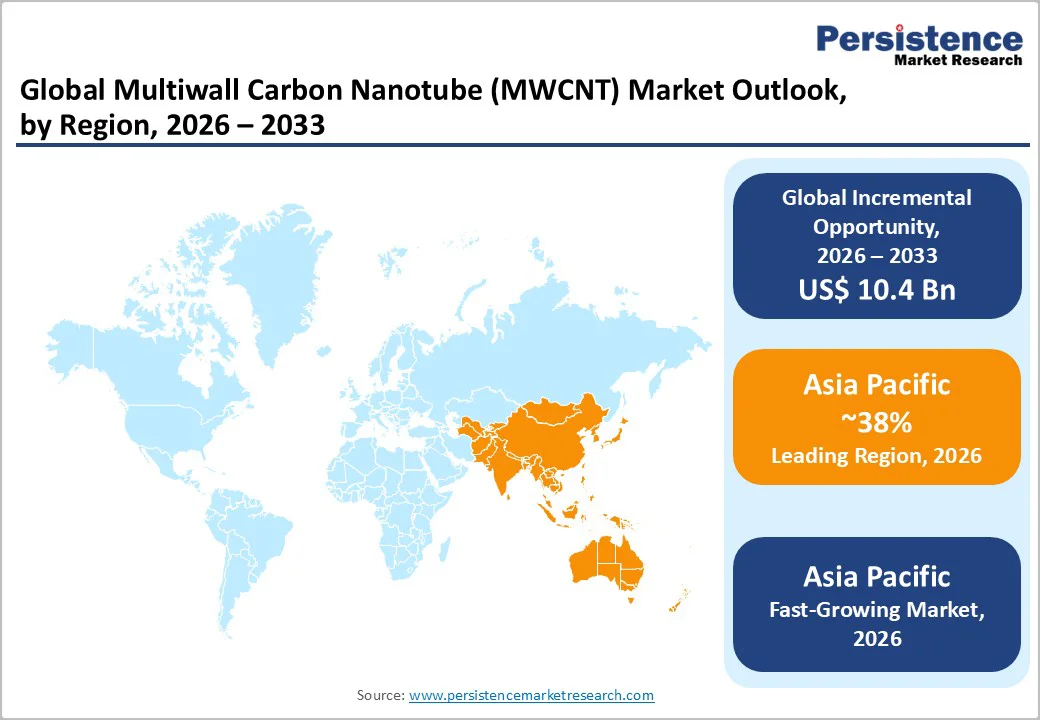ID: PMRREP34431| 165 Pages | 13 Dec 2025 | Format: PDF, Excel, PPT* | Chemicals and Materials

The global multiwall carbon nanotube (MWCNT) market size is likely to be valued at US$ 7.0 billion in 2026 and is estimated to reach US$ 17.4 billion by 2033, growing at a CAGR of 13.9% during the forecast period 2026−2033. Rising demand for lightweight, high-strength, and conductive nanomaterials in electronics, energy storage, and aerospace sectors is primarily responsible for market growth. Concurrent advances in manufacturing and functionalization techniques, and increasing end-user demand from automotive, healthcare, and construction industries are also playing a central in broadening market horizons. These factors, underpinned by rising investment in research and development (R&D) and expanding applications across sectors, support the projected robust market growth.
| Report Attribute | Details |
|---|---|
|
Multiwall Carbon Nanotube Market Size (2026E) |
US$ 7.0 Bn |
|
Market Value Forecast (2033F) |
US$ 17.4 Bn |
|
Projected Growth (CAGR 2026 to 2033) |
13.9% |
|
Historical Market Growth (CAGR 2020 to 2025) |
13.4% |

The increasing demand for lightweight composites is significantly influencing the growth of multiwall carbon nanotubes. Industries such as automotive, aerospace, and electronics are under continuous pressure to enhance performance while reducing weight to improve fuel efficiency and lower emissions. MWCNTs, with their exceptional tensile strength and low density, provide the ideal reinforcement for advanced composite materials. By integrating MWCNTs, manufacturers achieve superior structural integrity without the added weight, enabling vehicles and aircraft to meet stringent regulatory standards for energy efficiency. A study published in Carbon journal indicates that MWCNT-reinforced composites can improve mechanical strength by up to 30%.
The shift toward electric vehicles and high-performance lightweight products further accelerates MWCNT adoption. Lightweight composites help extend battery life and increase range, which is critical in the EV sector, while also allowing electronics and consumer goods to maintain durability while reducing overall material usage. Industries focusing on sustainability and high-performance applications increasingly view MWCNT-based composites as a strategic solution. The ability to enhance product efficiency, performance, and sustainability positions lightweight composites as a pivotal factor driving MWCNT integration across multiple high-value sectors.
Regulatory and health safety concerns pose a significant challenge due to the potential risks associated with exposure to multiwall carbon nanotubes. Studies indicate that inhalation or prolonged contact with these nanomaterials can cause respiratory issues, skin irritation, and other toxicological effects. Stringent regulations on manufacturing, handling, and disposal have been imposed in many regions to mitigate occupational and environmental hazards. Compliance with these standards increases operational costs for manufacturers, while non-compliance risks legal penalties, recalls, and reputational damage, impacting overall business sustainability.
The uncertainty surrounding long-term health effects further limits adoption across industries. Companies are compelled to invest in extensive safety protocols, personal protective equipment, and specialized training programs for employees, creating additional operational complexities. This cautious approach slows integration into commercial applications and restricts market growth in sectors with high safety sensitivity, such as healthcare, consumer electronics, and food packaging. As industries weigh the benefits against potential liabilities, regulatory and health safety concerns continue to act as a key restraint, influencing investment decisions, supply chain strategies, and overall product development initiatives.
Emerging biomedical and drug delivery applications represent a transformative opportunity due to the unique structural and chemical properties of MWCNTs. Their high surface area, exceptional mechanical strength, and capacity for functionalization allow precise targeting and controlled release of therapeutic agents. These characteristics enable the development of advanced drug delivery systems that improve bioavailability, reduce side effects, and enhance the effectiveness of treatments for complex diseases such as cancer, neurological disorders, and cardiovascular conditions. The ability to conjugate multiple drugs or imaging agents on a single nanotube platform creates potential for simultaneous therapy and diagnostics, redefining treatment paradigms.
Integration of MWCNTs into biomedical devices and drug delivery solutions also addresses the growing demand for personalized and precision medicine. With increasing focus on minimally invasive therapies and real-time monitoring of treatment outcomes, multiwall carbon nantubes offer scalable solutions for next-generation healthcare applications. Their compatibility with various biomaterials and adaptability to different administration routes, including oral, intravenous, and transdermal, positions them as a versatile tool in therapeutic innovation. This technological leverage translates into significant competitive advantage for companies investing in research and development within this space, driving differentiation and long-term value creation in advanced healthcare solutions.
Standard MWCNTs are anticipated to hold the leading position with approximately 45% of the multiwall carbon nanotube market revenue share in 2026. Their widespread adoption is attributed to cost-effectiveness, consistent quality, and compatibility with diverse applications such as composites, electronics, and conductive materials. The intrinsic conductivity and mechanical strength of standard MWCNTs allow seamless integration without additional functionalization, making them suitable for large-scale industrial deployment. Their baseline performance, combined with affordability, positions them as the preferred choice for manufacturers seeking reliable and economically viable nanomaterial solutions.
Functionalized MWCNTs are expected to be the fastest-growing segment during 2026-2033, driven by their increasing demand in biomedical, drug delivery, and advanced sensor applications. Surface modifications enhance dispersion in solvents and matrices, improving efficacy and performance in specialized uses such as targeted therapeutics. This adaptability enables customized solutions tailored to complex applications, supporting precision medicine and high-performance sensor development. The growth reflects the industry’s focus on high-value, technologically advanced applications, highlighting functionalized MWCNTs as a strategic investment area with strong future potential.
Electronics remains the dominant segment, projected to hold a market share of approximately 35% in 2026. The segment’s dominance is driven by the use of MWCNTs in conductive films, transistors, and other electronic components where high conductivity and thermal stability are critical. Growing adoption of IoT devices, advanced sensors, and 5G technology has further reinforced demand. MWCNTs improve device performance, reliability, and energy efficiency, making them a preferred material for electronics manufacturers seeking scalable, high-performance solutions in a rapidly evolving technological landscape.
Energy storage is expected to chart the highest growth trajectory between 2026 and 2033, powered by the rising demand for multiwall carbon nanotubes in EV batteries and advanced energy systems. MWCNTs enhance battery performance by improving conductivity, charge-discharge efficiency, and lifecycle stability. Increasing investment in renewable energy storage, portable electronics, and grid-scale solutions fuels adoption across applications. The segment’s growth reflects the shift toward sustainable and high-efficiency energy solutions, positioning MWCNTs as a key enabler of next-generation battery technologies and advanced energy storage systems, creating significant opportunities for manufacturers and technology developers.
Aerospace & defense is poised to dominate in 2026, projected to hold an estimated 30% of the MWCNT market revenue share in 2026. The leadership of this sector is owing to the integration of MWCNT-based composites in aircraft and defense structures, offering superior corrosion resistance, mechanical strength, and lightweight properties. Increasing regulatory focus on sustainability and fuel efficiency has accelerated adoption, while next-generation aircraft and defense platforms rely on advanced materials for performance and safety. MWCNTs enable long-term durability and structural reliability, making them a strategic choice for aerospace and defense manufacturers globally.
Automotive is expected to be the fastest-growing end-user industry from 2026 to 2033, fueled by the heightening demand for EVs and lightweight components. MWCNTs enhance battery electrodes, improve electrical conductivity, and reduce overall vehicle weight, supporting energy efficiency and extended driving range. Growth is also driven by the push for high-performance, sustainable materials in passenger and commercial vehicles. The segment reflects the automotive industry’s focus on advanced materials to meet evolving environmental regulations, performance requirements, and consumer expectations, creating significant opportunities for innovative MWCNT applications.

North America is expected to maintain a leading market position in 2026 on the back of its strong industrial infrastructure and high adoption of advanced technologies. The United States and Canada are investing heavily in sectors such as electronics, aerospace, defense, and healthcare, where multiwall carbon nanotubes enhance performance through superior conductivity, mechanical strength, and thermal stability. The presence of established manufacturing capabilities, coupled with innovation-focused research institutions, enables rapid development and commercialization of advanced materials. Strategic partnerships between industry and academia further reinforce the region’s technological leadership and application expertise.
The regional multiwall carbon nanotube market growth is underpinned by the increasing demand for energy-efficient solutions and next-generation devices. Integration of carbon nanotubes into electric vehicle components, high-performance batteries, and biomedical devices is accelerating, supported by government initiatives and private-sector investment. Advanced R&D capabilities, well-developed supply chains, and early adoption of cutting-edge applications position North America as a key innovation hub. The combination of technological expertise and strong industrial demand ensures continued expansion and leadership in high-value applications for advanced carbon-based materials.
Europe is projected to strengthen its position during the 2026-2033 forecast period, driven by a focus on high-performance industrial applications. Countries such as Germany, France, and the UK are prioritizing the integration of multiwall carbon nanotubes into sectors such as aerospace, defense, and precision electronics. Emphasis on material durability, thermal management, and compliance with stringent regulatory standards enables manufacturers to develop advanced composites and high-efficiency components. This strategic approach positions Europe as a hub for innovation and specialized applications within the global nanomaterials landscape.
Market growth in the region is supported by an unwavering commitment to energy efficiency and sustainability. Adoption in advanced battery technologies, lightweight automotive components, and renewable energy systems is being accelerated through government incentives and industrial initiatives. Collaborative R&D networks and technology clusters facilitate faster commercialization of innovative solutions. Rising demand for high-performance materials in critical sectors, coupled with Europe’s focus on precision engineering and quality-driven adoption, ensures steady expansion and technological leadership in the development and application of advanced carbon-based materials.
In 2026, Asia Pacific is projected to command around 38% of the multiwall carbon nanotube market share. The region’s dominance is anchored in its robust manufacturing ecosystem, particularly in China, Japan, and South Korea, which combine large-scale production capacity with advanced nanomaterials research. Strong government support through strategic initiatives promoting high-tech materials, aerospace, automotive electrification, and energy storage accelerates adoption. Asia Pacific’s emphasis on integrating MWCNTs into next-generation electronics, EV batteries, and biomedical devices provides both scale and technological sophistication, allowing companies to leverage cost advantages while meeting stringent performance requirements. Strategic collaborations between universities, research institutes, and private enterprises further reinforce the region’s technological edge, enabling faster commercialization of innovative MWCNT applications.
The Asia Pacific market is also forecasted to be the fastest-growing through 2033, on account of the convergence of rising industrial demand and expanding application areas. Rapid electrification of vehicles, investment in renewable energy infrastructure, and growing precision healthcare initiatives drive MWCNT uptake across multiple high-value segments. Supply chain efficiencies, combined with proximity to key raw material sources and growing R&D capabilities, allow manufacturers to innovate and scale efficiently. The growing consumer electronics and IoT markets in Asia-Pacific create a continuous demand pipeline for conductive and high-performance MWCNT materials. This combination of industrial scale, technological investment, and diversified application demand positions Asia-Pacific as both the dominant and fastest-expanding market globally.

The global multiwall carbon nanotube market structure is moderately concentrated, with a few leading chemical and nanomaterial companies capturing a significant share of high-purity, high-specification products. These top players focus on high-value applications in electronics, energy, aerospace, and biomedical sectors, where performance and reliability are critical. Their strong R&D capabilities, established supply chains, and technological expertise allow them to dominate advanced segments, offering tailored solutions that meet stringent industry standards.
At the same time, numerous smaller and regional players cater to lower-cost or lower-specification applications, serving industries with less demanding performance requirements. While these companies contribute to market volume, the majority of value is captured by the leading firms. Their focus on innovation and specialized offerings ensures sustained leadership in premium segments, reinforcing the market’s moderate concentration structure.
The global multiwall carbon nanotube market is projected to reach US$ 7.0 billion in 2026.
Strengthening demand for lightweight, high-strength, and conductive materials across electronics, energy storage, automotive, and aerospace sectors is driving the market.
The market is poised to witness a CAGR of 5.4% from 2026 to 2033.
Key market opportunities lie in expanding applications of MWCNTs in batteries, electric vehicles, advanced composites, 5G electronics, and sustainable material innovations.
Some of the key market players include OCSiAl Group, Arkema SA, Nanocyl SA, LG Chem Ltd., Jiangsu Cnano Technology Co., Ltd., Cabot Corporation, and Showa Denko Materials Co., Ltd.
| Report Attribute | Details |
|---|---|
|
Historical Data/Actuals |
2020 – 2025 |
|
Forecast Period |
2026 – 2033 |
|
Market Analysis |
Value: US$ Bn |
|
Geographical Coverage |
|
|
Segmental Coverage |
|
|
Competitive Analysis |
|
|
Report Highlights |
|
By Diameter
By Application
By End-use Industry
By Region
Delivery Timelines
For more information on this report and its delivery timelines please get in touch with our sales team.
About Author